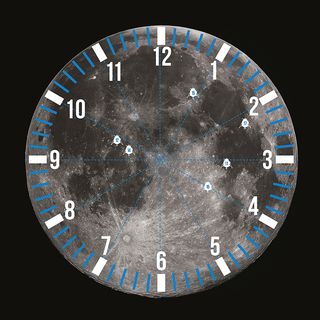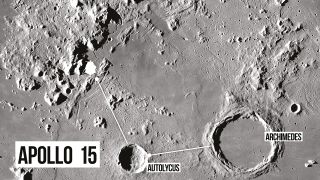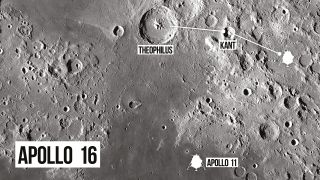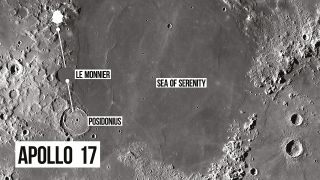Apollo landing sites: An observer's guide on how to spot them on the moon
Gaze upon the lunar surface tonight, and you’ll see where astronauts, rovers, and landers stepped onto another world.

Today, there is a lot of excited talk about going to the moon. Again. Shining brightly in our sky, it calls to us like a celestial siren, just as it always has done. NASA is still debating whether it should send astronauts straight to Mars, bypassing the moon altogether, or only go to Mars after a number of successful precursor missions to Earth's natural satellite.
Meanwhile, the European Space Agency is looking to the moon as the potential site of a scientific outpost, where different nations could work together in a 'lunar village,' much like international scientists now work in Antarctica.
Private companies are also planning to mine the moon for resources, and there's even a competition to land robot rovers on the moon and have them send live videos back to Earth.
Related: How long would it take to walk around the moon?
With all this going on, it's important to remember we've already been to the moon. True, it happened a long time ago but the Apollo program led to missions that were a spectacular success and represented a golden age of exploration. It was a time when enormous rockets, gleaming white, thundered into the sky, roaring like dragons, carrying brave explorers across the gulf of space, traveling much further than we could possibly go today.
Between 1969 and 1972, six Apollo missions took teams of three astronauts across over 250 miles (400 kilometers) of space to the moon, set two of them down on its surface, and brought them all home safely again. A seventh mission, Apollo 13, famously failed to land on the moon, but the astronauts survived a flight around the moon. Today, those daring missions are as fascinating as ever.
Many people have asked why astronomers don't turn the Hubble Space Telescope towards the moon to take photos of the Apollo spacecraft. But not even the Hubble could see a four-meter wide Apollo spacecraft on the moon.
Hubble is essentially a light bucket, designed to collect the faint, ghostly light of faraway galaxies, nebulas and planets. It can't zoom in on things in its own backyard.
Orion GoScope II 70 Telescope Moon Kit: $84.99 at Amazon
If you know a youngster who can't get enough of the moon, then they'll be delighted with views through the Orion GoScope II. Revealing craters and seas up close, this little telescope comes with a carry case and moon map.

This article is brought to you by All About Space.
All About Space magazine takes you on an awe-inspiring journey through our solar system and beyond, from the amazing technology and spacecraft that enables humanity to venture into orbit, to the complexities of space science.
To see Apollo hardware, you have to go to the moon, and then either land next to the actual spacecraft, as the rovers might do later this year or next, or look down on them from orbit. The Lunar Reconnaissance Orbiter (LRO), has done just that, and has taken amazing images of the Apollo landing sites from orbit showing not just the spacecraft themselves, but the lunar rovers parked where they were left, and even the trails of bootprints left in the lunar dust by the explorers.
So, if you were hoping to see Apollo hardware on the moon through your telescope, you've no chance, sadly. However, you can see the Apollo landing sites if your telescope is good enough—and we're going to tell you how, and where, to find them.
How to view the Apollo landing sites

First, you need to know the general areas of the landing sites, and the key to doing that is to think of the moon as the face of a clock, with 12 o'clock at the top and 6 o'clock at the bottom. You can then find the rough areas of each mission's landing site quite easily, using the charts included in this guide.
Having found the general areas of the landing sites, you can then zoom in on those to pin-down the actual landing sites. You do this by looking for certain features the landing sites were close to, such as a large crater or a valley. Again the charts will help you.
Note: The charts are oriented correctly for the 'upside down' view seen through most telescopes.
Apollo 11

- Telescope with magnification of 50x or more
- Mare Tranquillitatis (Sea of Tranquility)
- Between first quarter and full
Finding the Apollo 11 landing site where Neil Armstrong took his "one small step" off the Eagle's ladder is quite easy.
Just find the large crater Theophilus and put it at the top of your field of view. You'll see an obvious 'promontory' of bright ground beneath the crater, jutting out into the darker lava sea. The 'Tranquility Base' is just beneath this striking feature.
Apollo 12

- Telescope with magnification of 50x or more
- Oceanus Procellarum (Ocean of Storms),close to crater Copernicus
- Between full and last quarter
One of the moon's most impressive craters will guide you towards the Apollo 12 landing site in the Ocean of Storms.
Just find the huge crater Copernicus, and place it at the bottom of your inverted field of view. To Copernicus' upper right you'll see the smaller crater Reinhold and beyond it the crater Lansberg. Apollo 12's landing site lies to the upper left of the 3.1-kilometer-deep Lansberg.
Apollo 14

- Telescope with magnification of 50x or more
- Fra Mauro, close to crater Ptolemaeus
- Between first quarter and full Moon
The Apollo 14 landing site can be found close to one of the most impressive and most photographed 'crater chains' on the moon's surface.
Once you have found craters Arzachel, Alphonsus, and Ptolemaeus, jump across to the right of Ptolemaeus, where you will find the smaller ring-like crater, Parry. The Apollo 14 landing site is just to the lower right of this crater.
Apollo 15

- Telescope with magnification of 100x or more
- Close to Hadley Rille,in the Apennine mountains
- Between first quarter and full Moon
The lunar module Falcon touched down in July 1971 in the most stunning location any Apollo mission visited—close to a meandering valley in the shadow of the Apennine mountains.
To find it, look for the break in the curve of the mountains, to the left of the crater Archimedes, past Autolycus and Aristillus. Apollo 15 landed above and to the left of these craters, in the foothills of the mountains.
Apollo 16

- Telescope with magnification of 100x or more
- The Descartes Highlands, close to the crater Kant
- First quarter to full
The landing site of the Apollo 16 lunar module 'Orion' is probably the most challenging to find.
If you place the crater Theophilus to the left of your eyepiece's field of view, you'll see a smaller, sharper-rimmed crater to its right. This is Kant, and Apollo 16 set down in the rugged highlands to its lower right.
Apollo 17

- Telescope with magnification of 100x or more
- Taurus-Littrow Valley
- First quarter to full
The final Apollo mission in December 1972 saw the lunar module Challenger land in a notch-like 'bay' on the southern shore of the Sea of Serenity.
To find it, put the shallow crater Posidonius at the bottom of your field of view. Follow the shoreline 'up' past the semi-circular Le Monnier bay. Continue upwards and you'll find the Apollo 17 landing site.
Join our Space Forums to keep talking space on the latest missions, night sky and more! And if you have a news tip, correction or comment, let us know at: community@space.com.
Get the Space.com Newsletter
Breaking space news, the latest updates on rocket launches, skywatching events and more!

All About Space is where stunning images combine with accessible and authoritative text to educate and inspire readers of all ages while taking them on a spectacular journey through the Solar System to the known limits of the universe. Characterized by quality and accessibility All About Space is a brand dedicated to delivering expert commentary on the latest cutting-edge research, technology and theories in an entertaining and visually stunning way.
Get fantastic offers by subscribing to the digital and/or print edition now. Subscribers get 13 issues per year!

